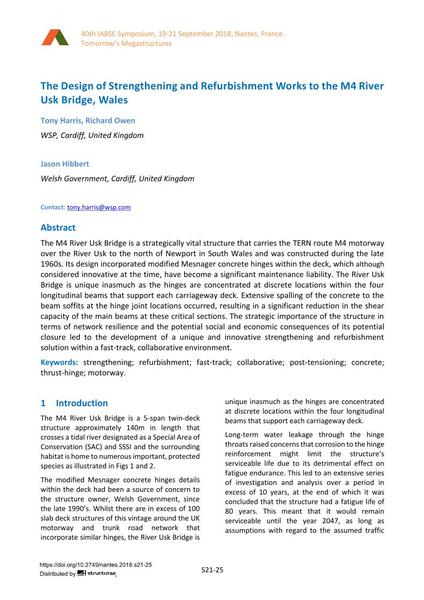The Design of Strengthening and Refurbishment Works to the M4 River Usk Bridge, Wales

|
|
|||||||||||
Bibliographic Details
| Author(s): |
Tony Harris
(WSP, Cardiff, United Kingdom)
Richard Owen (WSP, Cardiff, United Kingdom) Jason Hibbert (Welsh Government, Cardiff, United Kingdom) |
||||
|---|---|---|---|---|---|
| Medium: | conference paper | ||||
| Language(s): | English | ||||
| Conference: | IABSE Symposium: Tomorrow’s Megastructures, Nantes, France, 19-21 September 2018 | ||||
| Published in: | IABSE Symposium Nantes 2018 | ||||
|
|||||
| Page(s): | S21-25 | ||||
| Total no. of pages: | 9 | ||||
| DOI: | 10.2749/nantes.2018.s21-25 | ||||
| Abstract: |
The M4 River Usk Bridge is a strategically vital structure that carries the TERN route M4 motorway over the River Usk to the north of Newport in South Wales and was constructed during the late 1960s. Its design incorporated modified Mesnager concrete hinges within the deck, which although considered innovative at the time, have become a significant maintenance liability. The River Usk Bridge is unique inasmuch as the hinges are concentrated at discrete locations within the four longitudinal beams that support each carriageway deck. Extensive spalling of the concrete to the beam soffits at the hinge joint locations occurred, resulting in a significant reduction in the shear capacity of the main beams at these critical sections. The strategic importance of the structure in terms of network resilience and the potential social and economic consequences of its potential closure led to the development of a unique and innovative strengthening and refurbishment solution within a fast-track, collaborative environment. |
||||
| Keywords: |
concrete refurbishment strengthening post-tensioning motorway fast-track collaborative thrust-hinge
|
||||
